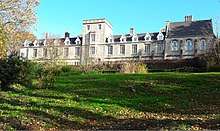St Beuno's Jesuit Spirituality Centre
St Beuno's Jesuit Spirituality Centre, known locally as St Beuno's College, is a spirituality and retreat centre in Tremeirchion, Denbighshire, Wales. Built in 1847 and opened in 1848, it served as home for the Victorian poet Gerard Manley Hopkins during his theology studies. In 2002 St Beuno's was categorised as a Grade II* listed building and a Welsh Historic Monument (Denbighshire CC, Record No. 26459).[1]
| St Beuno's | |
|---|---|
| St Beuno's Jesuit Spirituality Centre | |
| St Beuno's College | |
 | |
 St Beuno's Location in Denbighshire | |
| OS grid reference | 307989, 374229 |
| Location | Tremeirchion, Denbighshire |
| Country | United Kingdom |
| Denomination | Roman Catholic |
| Website | Beunos.com |
| History | |
| Former name(s) | St Beuno's College |
| Status | Active |
| Founded | 1846 |
| Founder(s) | Fr Randal Lythgoe SJ |
| Dedication | Saint Beuno |
| Associated people | Gerard Manley Hopkins SJ Ignatius Scoles SJ |
| Architecture | |
| Functional status | Spirituality Centre |
| Heritage designation | Grade II* listed[1] |
| Designated | 2002 |
| Architect(s) | Joseph Hansom |
| Groundbreaking | 1847 |
| Completed | 1848 |
| Administration | |
| Parish | Vale of Clwyd |
| Deanery | Rhyl[2] |
| Diocese | Wrexham |
| Province | Cardiff |
History
Foundation

In 1832, Following the Act of Catholic Emancipation of 1829, the Jesuits came to North Wales and founded St Winefride's Church in nearby Holywell, Flintshire.[3] In 1846, Fr Randal Lythgoe, the Provincial of the Jesuits in Britain, visited Holywell and travelled around the around. When he came to Tremeirchion, to see some farm land that the Jesuits owned, he immediately decided that this should be the site for a new college. The college would teach theology to Jesuits in training to be priests. It was decided to name the college after a local saint, St Beuno, instead of a saint associated with the Jesuits.
Construction

St Beuno's was designed by the architect Joseph Aloysius Hansom, known for the Hansom cab. He went on to design many churches for the Jesuits, such as the Oxford Oratory, St Walburge's Church in Preston, the Church of the Immaculate Conception, Spinkhill in 1846, St David's Church, Dalkeith in 1853, Annunciation Church, Chesterfield in 1854, St Joseph's Church, Leigh in 1855, and the Church of the Holy Name of Jesus, Manchester in 1871. The outside walls were made of stone, with Gothic gargoyles and stone carving, and inside were broad corridors and large but simple rooms.
In the late 1870s, the poet Gerard Manley Hopkins while studying to become a Jesuit priest, described the building, "It is built of limestone, decent outside, skimping within, Gothic like Lancing College done worse."[4]
Originally, St Beuno's College was a quadrangle enclosing a garden. On the west side of the quad was a basement corridor containing the recreation Room, schoolroom, two private rooms and the entrance Hall, above which was a library, the rector's room and a parlour. On the south side, the highest part of the quadrangle, were three galleries which housed the teachers and the students. On the north side was the refectory.
Developments
20 years after its construction, St Beuno's College needed to the extended to accommodate the increased numbers of Jesuits training there. Extra rooms in the attics were added and a new North Wing was built to the left of the tower.
Originally, heating for the lower floor was provided by heat from greenhouse below the west front being channelled into the house. Fresh water was provided from local streams and kept in tanks, which still exist above the terraces, and food was grown locally both in the college's grounds and on the adjacent college farm. The college had its own gas works. There was also a school built for local children.
Tertianship
In 1926, the college ceased being a theology college. The Jesuit students were moved to Heythrop College in Oxfordshire. Instead, St Beuno's became a place of study for the last year of Jesuit training, the tertianship.
During the Second World War it was a place of refuge to many Jesuit novices who were sent from Manresa House in Roehampton, during and after the Blitz. When the war finished, it reverted to being a tertianship.

Retreat centre
From 1970 the house had begun to open to religious sisters on first 8-day and then 30-day retreats. During the 1970s, as those engaged in the tertianship became increasingly uneasy living in the countryside, the retreat work grew from strength to strength. In 1980, St Beuno's became a retreat centre.
St Beuno's has a programme of retreats all the year round, from weekends to 30 days. It also offers courses in Ignatian Spirituality from one to six months' duration.[5]
Tremeirchion Rood Cross
In 1862 the College was presented with a medieval cross by a Mr Hynde, who bought it for £5 from the Anglicans at Corpus Christi, Tremeirchion. The Tremeirchion Rood of Grace stood for 140 years on a plinth at the entrance to St Beuno's before being restored and then translated back to Tremeirchion churchyard as a Millennium gift. It now stands beneath the yew under which in the mid-19th century it had been found buried.
Rock Chapel
In 1866 the 'Rock Chapel', was built on a wooded hill to the south of St Beuno's. It was designed by a Jesuit student, Ignatius Scoles, who had followed the footsteps of his father, Joseph John Scoles, and trained as an architect before joining the Jesuits to become a priest. He went on to design St Wilfrid's Church in Preston, Brickdam Cathedral and Georgetown City Hall in Guyana.
- Rock Chapel
%2C_Sant_Beuno%2C_Tremeichion_46.jpg) Interior
Interior%2C_Sant_Beuno%2C_Tremeichion_42.jpg) Stained glass inside
Stained glass inside%2C_Sant_Beuno%2C_Tremeichion_43.jpg) Stained glass inside
Stained glass inside
See also
References
- St Beuno's College, Tremeirchion from British listed buildings, retrieved 14 August 2013
- Deaneries from Diocese of Wrexham retrieved 14 August 2013
- St Winefride's Church Holywell from British Listed Buildings, retrieved 5 December 2018
- Poems and Prose of Gerard Manley Hopkins By Gerard Manley Hopkins, W. H. Gardner p.175
- Dates and Historical details from "Canute's Tower St Beuno's" by Paul Edwards, Published by Gracewing in 1990, ISBN 0-85244-151-7
External links
| Wikimedia Commons has media related to St Beuno’s Ignatian Spirituality Centre. |
